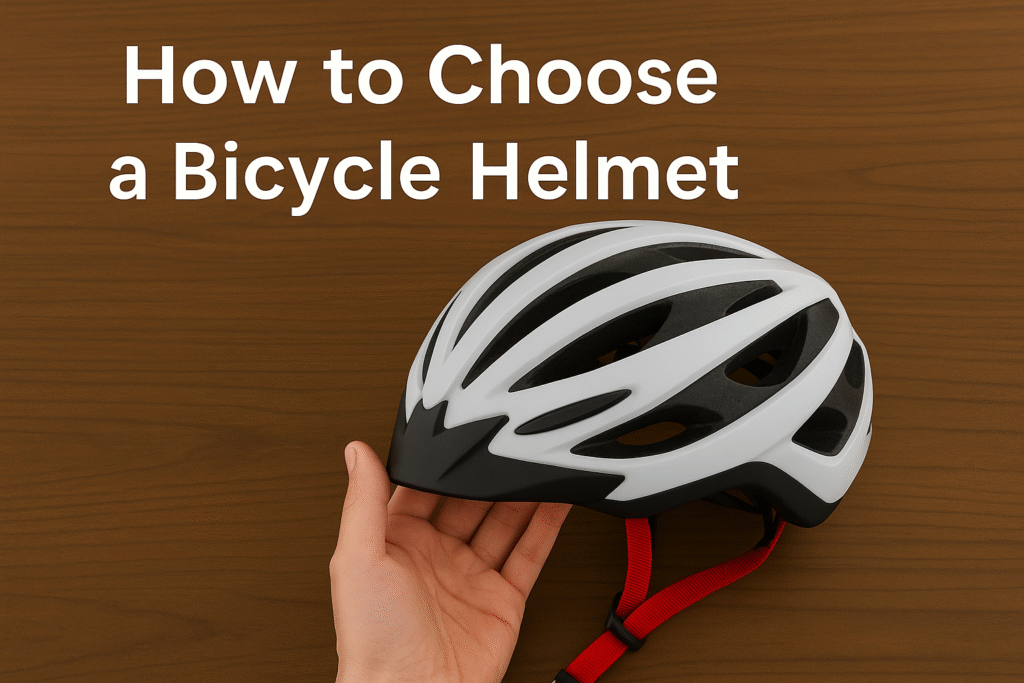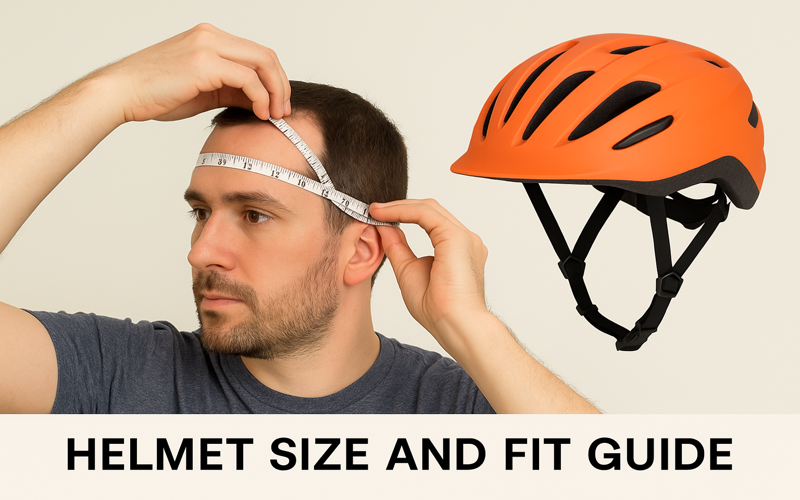1. Introduction
Choosing the right helmet starts with knowing exactly how to choose bicycle helmet that fits your needs, style, and safety standards. Whether you’re searching based on bike helmet sizes by age or comparing features in the best road bicycle helmet, making an informed decision is key to riding confidently.
Helmets today come in a variety of shapes, fits, and features—each designed for different riding conditions like commuting, mountain trails, or road racing. From cool bike helmets for adults to youth-friendly models, selecting the correct type and size ensures not only comfort but essential protection. In this guide, you’ll learn how to pick the perfect helmet for your riding style with safety, performance, and design in mind.

Table of Contents
2. Why Choosing the Right Helmet Matters
- Selecting the correct helmet directly impacts your safety and protection during cycling, especially in the event of a fall or crash.
- A well-fitted helmet helps reduce the risk of head injuries, which is why learning how to choose a bicycle helmet is essential for all riders.
- The right size and design offer better comfort, encouraging regular use, whether you’re selecting a mountain bike helmet or a commuter model.
- Different riding styles require specific features, so understanding your needs—like whether you need the best road bicycle helmet or one with added ventilation—is key.
- Age-appropriate sizing is critical for both children and adults; using the correct bike helmet sizes by age ensures a snug and secure fit.
- A properly chosen helmet includes updated safety features such as MIPS or high-quality shell construction, offering better protection than outdated or ill-fitting models.
- Beyond protection, a good helmet also offers style and confidence—many cyclists look for the best looking bike helmet or cool bike helmets for adults that match their personal taste.
- Humanize 180 words
3. Understanding Helmet Types Based on Riding Style
- Road bike helmets are lightweight, aerodynamic, and well-ventilated, making them ideal for speed-focused cyclists looking for the best road bicycle helmet.
- Mountain bike helmets offer extended rear head coverage, stronger outer shells, and visors to protect against branches and debris on rugged trails.
- Commuter helmets focus on comfort and visibility, often designed with integrated lights or reflective elements for safe urban riding.
- Hybrid helmets combine features of road and mountain styles, making them versatile for casual riders learning how to choose bicycle helmet.
- BMX and skate-style helmets have a solid shell and lower-profile fit, offering impact protection for tricks and jumps.
- Each helmet type is built for a specific environment, so selecting the right one based on your riding style ensures optimal performance and safety.
- If you’re unsure which to choose, referring to a mountain bike helmet size guide or brand-specific recommendations can help find the best fit and protection.
4. Helmet Size and Fit Guide

a. How to Measure Your Head Size
- Take a flexible measuring tape and circle it around the broadest part of your head, positioning it approximately one inch above your eyebrows.
- Note the measurement in centimeters, as most bike helmet sizes by age and brand guides use metric units.
- Measure more than once to ensure accuracy before selecting a helmet.
b. Matching Size with Helmet Brands
- Check the sizing chart provided by the helmet brand, since measurements and fit can differ from one manufacturer to another.
- Most brands offer small, medium, and large options, but some also include youth or XL sizes for broader coverage.
- Refer to a road or mountain bike helmet sizing chart to find the right fit if you’re uncertain which size suits your specific riding style.
c. Helmet Fit Checklist

- The helmet must rest evenly on your head, positioned low on the forehead rather than angled backward.
- Straps should form a snug “Y” shape just below your ears and fasten comfortably under your chin.
- There should be no pressure points or wobble when you shake your head, which is key when learning how to choose a bicycle helmet.
- A properly fitted helmet ensures both comfort and safety, making it more likely you’ll wear it every ride.
5. Top Safety Features to Look For
- Choose a helmet certified by recognized safety standards such as CPSC, EN1078, or ASTM to ensure reliable protection.
- Look for MIPS (Multi-directional Impact Protection System) technology, which adds an extra layer of defense against rotational impacts.
- A high-quality outer shell made from polycarbonate or ABS helps absorb external force during a crash.
- Inner EPS foam lining should be dense and well-molded to cushion the head and reduce injury risk.
- Good ventilation is essential for comfort and can prevent overheating during long rides.
- Reflective details and integrated rear lights enhance visibility, especially in low-light conditions, and are ideal for those seeking the best road bicycle helmet or cool bike helmets for adults.
- Adjustable chin straps and secure buckles ensure a snug fit, which is critical when learning how to choose a bicycle helmet that performs well under impact.
- A removable liner adds comfort and makes the helmet easier to clean, extending its lifespan and hygiene.
6. Style and Design: Function Meets Fashion
- Modern helmets balance safety with aesthetics, offering designs that appeal to both casual and performance-focused riders.
- Many cyclists today prefer the best looking bike helmet that also meets safety standards, combining fashion with function.
- Sleek road helmets, rugged mountain bike styles, and cool bike helmets for adults allow riders to express personality without sacrificing protection.
- Helmets come in a variety of colors and finishes, helping improve visibility while matching your gear or bike.
- Some designs include integrated visors, reflective elements, or rear lights, which add both flair and practicality.
- When considering how to choose a bicycle helmet, don’t overlook comfort features like inner padding, strap adjustability, and overall helmet shape that matches your head profile.
- For riders who value both performance and style, selecting a helmet that looks great and fits well enhances both confidence and safety on every ride.
7. Helmet Accessories and Add-ons
- Helmet covers are useful for protecting against rain, wind, and cold, with options like the best cycling helmet cover offering weatherproof performance and added visibility.
- Clip-on lights or built-in rear LEDs enhance visibility during low-light rides, making them a smart addition for commuters and road cyclists.
- Visors help block sunlight and debris, especially valuable for mountain biking or off-road trails.
- Replacement padding improves comfort and hygiene over time, ensuring your helmet remains fresh and well-fitted.
- Chin guards or full-face add-ons are available for certain mountain bike helmet models, offering extra protection for technical terrain.
- Reflective decals or stickers offer an easy way to boost both visibility and appearance while still maintaining full safety performance.
- Anti-sweat liners and moisture-wicking pads improve comfort during long rides, especially for those seeking cool bike helmets for adults.
- Buckle upgrades and strap adjusters help enhance fit and are worth considering when learning how to choose a bicycle helmet for daily use.
8. Best Practices for Buying a Helmet
- Always start by understanding how to choose a bicycle helmet that matches your riding style, head shape, and comfort needs.
- Check for certified safety labels such as CPSC, EN1078, or ASTM to ensure the helmet meets protection standards.
- Use sizing guides or try the helmet on to confirm it aligns with your measurements, especially when comparing bike helmet sizes by age.
- Shop from reputable brands or stores that offer return policies and product warranties.
- If buying online, read customer reviews to learn about comfort, fit, and durability.
- Prioritize fit and function over looks, though many brands now offer the best looking bike helmet options that don’t sacrifice safety.
- Consider your riding environment—urban, mountain, or road—and choose a design that suits your needs, such as the best road bicycle helmet or trail-specific models.
- Factor in added features like ventilation, padding, and strap adjustability, which can enhance both safety and riding experience.
9. Conclusion
- Choosing the right helmet is essential for safety, comfort, and performance, no matter your riding style or experience level.
- Understanding how to choose a bicycle helmet helps ensure a proper fit, which is key to reducing the risk of injury.
- Considering factors like helmet type, size, safety certifications, and additional features will guide you toward the best option.
- Whether you’re looking for the best road bicycle helmet, a stylish design, or one that fits specific bike helmet sizes by age, taking the time to evaluate your needs pays off.
- A well-fitted, high-quality helmet that suits your preferences makes every ride safer and more enjoyable.
10. FAQs
Q1: How do I choose the right bicycle helmet size?
Place a soft measuring tape around the largest part of your head, just above your eyebrows, to accurately determine your head size. Then compare the result with the brand’s sizing chart. If you’re shopping for kids, refer to specific bike helmet sizes by age to ensure a proper fit.
Q2: In what ways are road cycling helmets designed differently from mountain biking helmets?
Road bike helmets are lightweight, aerodynamic, and ventilated—ideal for speed and long-distance rides. Mountain bike helmets offer more coverage, visors, and impact resistance. Use a mountain bike helmet size guide to match the right fit and style.
Q3: Can I wear a stylish helmet without compromising safety?
Yes, many of the cool bike helmets for adults are both fashionable and safety-certified. Always check for standards like CPSC, EN1078, or ASTM to ensure you’re not trading protection for aesthetics.
Q4: How often should I replace my bicycle helmet?
You should replace your helmet every 3–5 years or immediately after a crash, even if there’s no visible damage. Materials inside the helmet can degrade over time and reduce effectiveness.
Q5: What features should I prioritize when buying a new helmet?
Look for proper fit, comfort, ventilation, and safety certifications. Extra features like MIPS protection, adjustable straps, and removable padding are also worth considering, especially when selecting the best road bicycle helmet or one for mixed-use.
